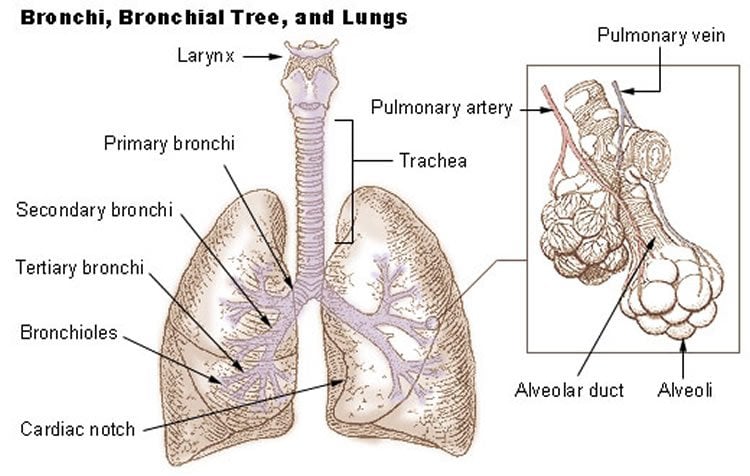Summary: Findings could lead to new treatments for asthma.
Source: RUB.
Researchers identified two types of olfactory receptors in human muscle cells of bronchi. If those receptors are activated by binding an odorant, bronchi dilate and contract – a potential approach for asthma therapy.
This is the conclusion drawn by a team headed by Prof Dr Dr Dr habil Hanns Hatt and Dr Benjamin Kalbe at the Department for Cellphysiology in Bochum. Together with colleagues from various clinics in Bochum, Cologne and Herne, the researchers from Ruhr-Universität Bochum published their report in the journal “Frontiers in Physiology”.
Banana-apricot scent dilates bronchioles
The newly discovered receptors in muscle cells are named OR2AG1 and OR1D2. The researchers also identified the activating odorous molecules as well as the signalling pathways that are triggered in the cells.
Amyl butyrate, a fruity scent with banana and apricot notes, stimulates the OR2AG1 receptor. Once the odorant binds, bronchioles relax and dilate. In the experiment, this effect was so strong that it could reverse the effect of histamine. Histamine is the substance released by the body if a person suffers from allergic asthma, which leads to constriction of the bronchi.
Approach for asthma therapy
“Amyl butyrate may help improve airflow in asthma sufferers,” concludes Hanns Hatt. “It can probably counteract not only the effect of histamine, but also that of other allergens that make breathing difficult.” The receptor might also be of interest in the treatment of other diseases, such as chronic obstructive pulmonary disease.

The researchers demonstrated, moreover, that amyl butyrate triggers the same signalling pathways in the muscle cells as in the olfactory cells in the nose.
Second receptor with opposite effect
The second receptor OR1D2 is sensitive to scents with floral, oily notes, for example lilial or bourgeonal. If the odorant binds to the receptor, the effect is opposite to that of the OR2AG1 receptor: the bronchial muscles contract. Moreover, pro-inflammatory substances are released from the cells.
For the purpose of the study, the researchers analysed human cell cultures provided by the team headed by PD Dr Jürgen Knobloch from the University Clinic Bergmannsheil in Bochum. The studied specimens were smooth muscles that, unlike striated muscles, cannot be contracted voluntarily.
Funding: Funcing provided by German Research Foundation, Ruhr-University Research School.
Source: Hanns Hatt – RUB
Image Source: This NeuroscienceNews.com image is in the public domain.
Original Research: Full open access research for “Olfactory Receptors Modulate Physiological Processes in Human Airway Smooth Muscle Cells” by Benjamin Kalbe, Jürgen Knobloch, Viola M. Schulz, Christine Wecker, Marian Schlimm, Paul Scholz, Fabian Jansen, Erich Stoelben, Stathis Philippou, Erich Hecker, Hermann Lübbert, Andrea Koch, Hanns Hatt and Sabrina Osterloh in Frontiers in Physiology. Published online August 4 2016 doi:10.3389/fphys.2016.00339
[cbtabs][cbtab title=”MLA”]RUB. “Olfactory Receptors Discovered in Bronchi.” NeuroscienceNews. NeuroscienceNews, 8 August 2016.
<https://neurosciencenews.com/olfactory-receptors-bronchi-4804/>.[/cbtab][cbtab title=”APA”]RUB. (2016, August 8). Olfactory Receptors Discovered in Bronchi. NeuroscienceNews. Retrieved August 8, 2016 from https://neurosciencenews.com/olfactory-receptors-bronchi-4804/[/cbtab][cbtab title=”Chicago”]RUB. “Olfactory Receptors Discovered in Bronchi.” https://neurosciencenews.com/olfactory-receptors-bronchi-4804/ (accessed August 8, 2016).[/cbtab][/cbtabs]
Abstract
Olfactory Receptors Modulate Physiological Processes in Human Airway Smooth Muscle Cells
Pathophysiological mechanisms in human airway smooth muscle cells (HASMCs) significantly contribute to the progression of chronic inflammatory airway diseases with limited therapeutic options, such as severe asthma and COPD. These abnormalities include the contractility and hyperproduction of inflammatory proteins. To develop therapeutic strategies, key pathological mechanisms, and putative clinical targets need to be identified. In the present study, we demonstrated that the human olfactory receptors (ORs) OR1D2 and OR2AG1 are expressed at the RNA and protein levels in HASMCs. Using fluorometric calcium imaging, specific agonists for OR2AG1 and OR1D2 were identified to trigger transient Ca2+ increases in HASMCs via a cAMP-dependent signal transduction cascade. Furthermore, the activation of OR2AG1 via amyl butyrate inhibited the histamine-induced contraction of HASMCs, whereas the stimulation of OR1D2 with bourgeonal led to an increase in cell contractility. In addition, OR1D2 activation induced the secretion of IL-8 and GM-CSF. Both effects were inhibited by the specific OR1D2 antagonist undecanal. We herein provide the first evidence to show that ORs are functionally expressed in HASMCs and regulate pathophysiological processes. Therefore, ORs might be new therapeutic targets for these diseases, and blocking ORs could be an auspicious strategy for the treatment of early-stage chronic inflammatory lung diseases.
“Olfactory Receptors Modulate Physiological Processes in Human Airway Smooth Muscle Cells” by Benjamin Kalbe, Jürgen Knobloch, Viola M. Schulz, Christine Wecker, Marian Schlimm, Paul Scholz, Fabian Jansen, Erich Stoelben, Stathis Philippou, Erich Hecker, Hermann Lübbert, Andrea Koch, Hanns Hatt and Sabrina Osterloh in Frontiers in Physiology. Published online August 4 2016 doi:10.3389/fphys.2016.00339






